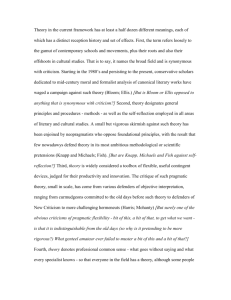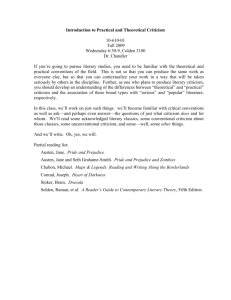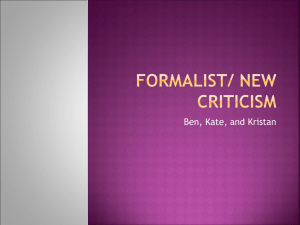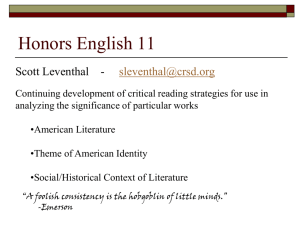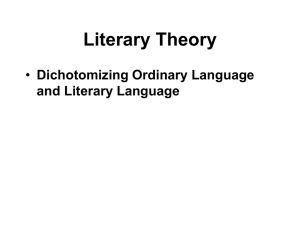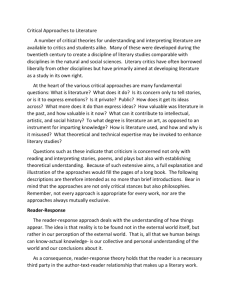Literary Terms I
advertisement
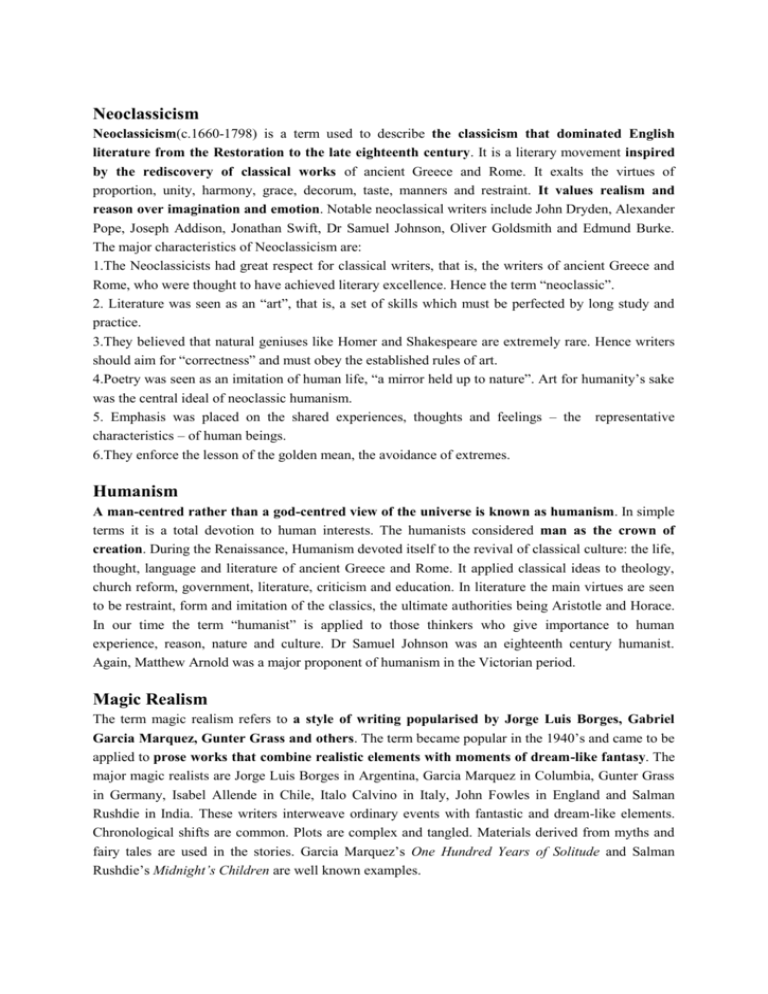
Neoclassicism Neoclassicism(c.1660-1798) is a term used to describe the classicism that dominated English literature from the Restoration to the late eighteenth century. It is a literary movement inspired by the rediscovery of classical works of ancient Greece and Rome. It exalts the virtues of proportion, unity, harmony, grace, decorum, taste, manners and restraint. It values realism and reason over imagination and emotion. Notable neoclassical writers include John Dryden, Alexander Pope, Joseph Addison, Jonathan Swift, Dr Samuel Johnson, Oliver Goldsmith and Edmund Burke. The major characteristics of Neoclassicism are: 1.The Neoclassicists had great respect for classical writers, that is, the writers of ancient Greece and Rome, who were thought to have achieved literary excellence. Hence the term “neoclassic”. 2. Literature was seen as an “art”, that is, a set of skills which must be perfected by long study and practice. 3.They believed that natural geniuses like Homer and Shakespeare are extremely rare. Hence writers should aim for “correctness” and must obey the established rules of art. 4.Poetry was seen as an imitation of human life, “a mirror held up to nature”. Art for humanity’s sake was the central ideal of neoclassic humanism. 5. Emphasis was placed on the shared experiences, thoughts and feelings – the representative characteristics – of human beings. 6.They enforce the lesson of the golden mean, the avoidance of extremes. Humanism A man-centred rather than a god-centred view of the universe is known as humanism. In simple terms it is a total devotion to human interests. The humanists considered man as the crown of creation. During the Renaissance, Humanism devoted itself to the revival of classical culture: the life, thought, language and literature of ancient Greece and Rome. It applied classical ideas to theology, church reform, government, literature, criticism and education. In literature the main virtues are seen to be restraint, form and imitation of the classics, the ultimate authorities being Aristotle and Horace. In our time the term “humanist” is applied to those thinkers who give importance to human experience, reason, nature and culture. Dr Samuel Johnson was an eighteenth century humanist. Again, Matthew Arnold was a major proponent of humanism in the Victorian period. Magic Realism The term magic realism refers to a style of writing popularised by Jorge Luis Borges, Gabriel Garcia Marquez, Gunter Grass and others. The term became popular in the 1940’s and came to be applied to prose works that combine realistic elements with moments of dream-like fantasy. The major magic realists are Jorge Luis Borges in Argentina, Garcia Marquez in Columbia, Gunter Grass in Germany, Isabel Allende in Chile, Italo Calvino in Italy, John Fowles in England and Salman Rushdie in India. These writers interweave ordinary events with fantastic and dream-like elements. Chronological shifts are common. Plots are complex and tangled. Materials derived from myths and fairy tales are used in the stories. Garcia Marquez’s One Hundred Years of Solitude and Salman Rushdie’s Midnight’s Children are well known examples. Symbolism In simple terms, symbolism refers to the practice of some writers to invest objects, actions or ideas with a symbolic meaning. A symbol is something specific which stands for an idea or a group of concepts and which has an emotional significance. For example, the rose is a symbol of beauty. Symbolism is the term that is most frequently used to describe Post-Romantic and Victorian verse. Symbolists proclaimed the supremacy of idea over fact. The term symbolist movement refers to a group of French writers beginning with Charles Baudelaire (Flowers of Evil). The most powerful influences in Symbolism were Baudelaire, Mallarme, Verlaine and Rimbaud. This movement has as its basis the doctrine that there exist inherent and systematic analogies between the human mind and the outer world, and also between the natural and the spiritual world. The Symbolist movement had an immense influence upon English and American poets, especially, Arthur Symons, Earnest Dowson, W.B.Yeats, Ezra Pound, Dylan Thomas, e.e. cummings and Wallace Stevens. Absurd School The term “literature of the absurd” is applied to a number of works in drama and fiction which share the sense that the human condition is essentially absurd, and that this condition can be effectively represented only in those works of literature which are themselves absurd. Absurdism highlights the isolation and alienation that human beings experience. It denies the existence of universal truth or value. Man has been thrown into a godless universe devoid of any religious, spiritual or metaphysical meaning. Absurdism has its roots in the movements of expressionism and surrealism as also in the writings of Franz Kafka(The Trial, Metamorphosis). After the 1940’s writers like Jean-Paul Sartre and Albert Camus started presenting man as an isolated existent who is cast into an alien universe. Human life comes from nothingness and moves towards nothingness. As Eugene Ionesco says, “Cut off from his religious, metaphysical and transcendental roots, man is lost; all his actions become senseless, absurd, useless.” The plays of Samuel Beckett (Waiting for Godot, Endgame) are the best examples. As one of the characters in Waiting for Godot remarks, “Nothing happens, nobody comes, nobody goes, it’s awful.” Some of the works of Jean Genet, Harold Pinter and Edward Albee are also in a similar mode. Martin Esslin’s The Theatre of the Absurd (1968) outlines the major features of Absurdism. Modernism It is a term used to describe the characteristics of literature and art between World War I and World War II. The four factors that led to modernism were: 1. Friedriche Nietzsche’s annunciation of the death of God. 2. Karl Marx’s view that consciousness is produced by socio-historical factors. 3. Sigmund Freud’s view of the unconscious as the source of human behaviour. 4. The ideas presented by James G Frazer in his The Golden Bough that stressed the connection between Christian tenets and pagan myths and rituals. Modernism embodies a lack of faith in Western civilization and culture. It provided a radical break with traditional modes of Western art, thought, religion and morality. Major themes of this movement include: 1. Attack on notions of hierarchy. 2. Experimentation in new forms of narrative like the stream of consciousness. 3. Doubt about the existence of objective reality. 4. Attention to alternative ways of thinking. 5. Self-referentiality The 1920’s are generally considered the golden age of modernism with works like T.S.Eliot’s The Wasteland, James Joyce’s Ulysses and Woolf’s Mrs Dalloway. Having witnessed the horrors of the World War I, the writers doubted whether traditional literary modes could adequately represent the harsh realities of the post-war world. Fragmentation, discontinuity, syntactical innovations etc are typical of modernist works. Post Modernism This notoriously ambiguous term is used to describe the characteristics of literature and art after World War II. The factors that contributed to the rise of post-modernism are: 1. Nazi totalitarianism and mass extermination of the Jews. 2. The threat of the atomic bomb. 3. The degradation of the environment. 4. The problem of over-population. Post-modernism can be seen as a response to the elitism of high-modernism. The term ‘postmodern’ began to be used during the 1960’s as a means of distinguishing the subversive fiction of writers such as John Barth, Donald Barthelme, Samuel Beckett and Jorge Luis Borges from the experimental works of high modernism composed during the 1920’s. It involves a continuation of the countertraditional experiments of modernism. At times it breaks away from modernist forms which had by then become conventional. To destroy the “high art” of modernism, it used “mass culture” in film, television, cartoon and music. Post-modernism is characterised by a disjointed, fragmented pastiche of high and low culture. Post-modernist works resist classification according to traditional literary norms as they blend different literary genres. Post-modernism attacks the use of sharp classifications such as male versus female, straight versus gay, white versus black, and imperial versus colonial. In The Postmodern Condition (1979), Jean Francois Lyotard defines post-modernism as “incredulity towards metanarratives”. What is required is a series of mininarratives. The rise of postmodernism was matched by the emergence of literary theory. The work of Roland Barthes, Jacques Derrida, Michel Foucault and Julia Kristeva quickly became associated with the principles of postmodernism. Jean Baudrillard is another major theorist of post-modernism. Structuralism Structuralism, as an intellectual movement, began in France in the 1950’s. Structuralists analyse literature on the explicit model of structuralist linguistics. In their analysis they use the theory of linguistics developed by Ferdinand de Saussure and the theory of semiotics (the study of signs) developed by Saussure and Charles Sanders Pierce. Structuralism was inaugurated by cultural anthropologist Claude Levi-Strauss who used the model of Saussurean linguistics to analyse cultural phenomena such as mythology, kinship relations and modes of preparing food. The structuralists are interested in langue and not in parole. Structuralist critics often apply a variety of linguistic concepts to the analysis of a literary text. The aim of structuralist criticism, as Jonathan Culler (Structuralist Poetics) puts it, is “to construct a poetics which stands to literature as linguistics stands to language”. Roland Barthes, Gerard Genette, Julia Kristeva and Tzvetan Todorov are major structuralist critics of literature. Post Structuralism Post-structuralism is an umbrella term that refers to such diverse writings as the Deconstruction of Jacques Derrida, the later works of Roland Barthes, the New Historicism of Michel Foucault, the psychoanalysis of Jacques Lacan and the feminist criticism of Gayatri Spivak. It criticised structuralism for its assumption that the system of signs in which language operates was stable and meaningful. Derrida attacked the systematic, quasi-scientfic pretensions of structuralism. He systematically proved that the arguments of Claude Levi-Strauss were fallacious. The term postmodern is sometimes used in place of post-structural. The major themes of post-structuralism are: 1. The importance given to ‘theory’. 2. The subversion of the basic assumptions of Western philosophy. 3. The decentering of the subject, for instance, “the death of the author” as proclaimed by Barthes. 4. The substitution of the “text” for the “work”. 5. The concept of discourse. Deconstruction The term deconstruction defies all our attempts at precise definition. Roughly defined, deconstruction is applied post-structuralism. It means “reading against the grain” or “reading the text against itself” with the purpose of “knowing the text as it cannot know itself”. Barbara Johnson defines it as “the careful teasing out of warring forces of signification within the text itself”. As Hillis Miller says, “deconstruction is not a dismantling of the structure of a text but a demonstration that it has already dismantled itself”. Jacques Derrida, the French thinker, is the originator of deconstruction. Derrida presents his ideas on deconstruction in three books, all published in 1967, entitled Of Grammatology, Writing and Difference and Speech and Phenomena. Deconstructive criticism aims to show any text defeats its own claim to have a clear meaning. It licences the reader to produce his own meanings out of it by an activity of semantic ‘freeplay’. Derrida attacks the logocentrism and phonocentrism of Western metaphysics. He coins the term difference by fusing ‘to differ’ and ‘to defer’. The other major deconstructionists are Paul de Man, Barbara Johnson, Hillis Miller and Geoffrey Hartman. Psychoanalytic criticism Psychoanalytic criticism is a form of criticism that makes use of the techniques of psychoanalysis in the interpretation of literature. The premises of psychoanalytic criticism were first developed by Sigmund Freud. He used literature to develop and illustrate some of his theories. The ‘Oedipus complex’ is one of the best-known examples for using literature to illustrate the theories of psychoanalysis. Freud argued that the individual psyche consisted of conscious, subconscious (or preconscious) and unconscious levels of activity. Previously many thinkers, following the lead of Rene Descartes, believed that we knew with complete clarity the contents of our own mind. But Freud convincingly argued that most of our actions are motivated by psychological forces over which we have very little control. Freud’s first major premise is that most of our mental processes are unconscious. The unconscious is a region in which we hide or repress our deepest desires and fears that that can only manifest itself through symbolic ways(as in dreaming). Freud’s later model of personality (1923) as consisting of the ‘superego’ the ‘ego’ and the ‘id’ also had a powerful effect on the conception of character for both writers and critics. By ‘condensation’ in dreams Freud meant the ways in which an image or word can acquire a number of meanings. The dream, in other words, can be interpreted as showing the dreamer aspects of his/her unconscious mind. Literary texts can also be read along similar lines. Psychoanalysis is a powerful form of knowledge, which can ‘explain’ hidden motives of characters and actions. It allows readers to become the analyst and the text the object of analysis. Such an approach will give the reader superiority over the text. In Freudian terms reading can be seen as unfolding of our consciousness and unconsciousness as well as that of the text. Reading is a form of self-definition, and the interaction of literary and psychoanalytic discourses can help us to understand this process. We might perhaps see literature as a kind of ‘superego’ or as an expression of the repressed desires and fears in the unconscious. Jacques Lacan, who is known as the French Freud, takes up the Freudian unconscious and relates it to language. He asserts that the unconscious is structured like language. The unconscious is not a chaotic mass of disparate material but as complex as the structure of a language. Following Ferdinand de Saussure, Lacan believes that meaning(s)are produced by the arbitrary relations between signifiers. Jacques Derrida, while not hostile to psychoanalysis per se, has argued that in practice its interpretations are pre-programmed to confirm its own findings. Michel Foucault also pointed out that psychoanalysis promoted a very particular point of view as the truth. Affective Fallacy The term was introduced by W.K.Wimsatt and Monroe C.Beardsley in an essay titled “ The Affectionate Fallacy”, published in 1946 and reprinted in The Verbal Icon(1964). It may be defined as the error of evaluating a literary work based on its emotional effects upon the reader. It is ‘a confusion between the poem and its results’. It is the antithesis of affective criticism, which is the practice of evaluating the effect that a literary work has on its reader or audience. This doctrine is a central concept in New Criticism. The reader-response criticism is an extreme reaction against the doctrine of affective fallacy. Intentional Fallacy The term was introduced by W.K.Wimsatt and Monroe C.Beardsley in an essay titled “ The Intentional Fallacy”, published in 1946. It may be defined as the error of evaluating a literary work based on the intention and purpose of its author. "The intention of the author is neither available nor desirable as a standard for judging the success of a work of literary art." This doctrine is a central concept in New Criticism. Negative Capability The term was introduced by John Keats in a letter written on December 21, 1817 to define a literary quality. It describes the capacity of a man to be “in uncertainties, mysteries, doubts, without any irritable reaching after fact and reason”. Keats feels “that with a great poet the sense of beauty overcomes every other consideration”. He says that Shakespeare possessed this quality while Coleridge did not. The term could be interpreted to mean aesthetic distance and objectivity. Myth A myth is a traditional story or legend offering an explanation to religious or supernatural phenomena such as the gods, the heroes and the forces of nature. Myth explains how something came to exist. The early writers made use of Greek and Roman myths. Writers like William Blake and W.B.Yeats have invented mythologies of their own. Most myths are related to social rituals; but anthropologists disagree as to whether rituals generated myths or myths generated rituals. Levi-Strauss attempted to analyse myths based on Saussure’s theory of linguistics. Mythology can be seen as a religion in which we no longer believe. Major myth critics include Northrop Frye, Robert Graves, Francis Fergusson, Maud Bodkin and Richard Chase. James Frazer’s The Golden Bough and Jessie Weston’s From Ritual to Romance are influential studies on myths. Archetype The term archetype refers to the recurrent narrative designs, patterns of action, character-types, themes and images which can be traced in a wide variety of literary works as also in myths, dreams and social rituals. Such recurrent items are the result of the universal patterns that exist in the human psyche. When such patterns are effectively presented in a literary work, it evokes a profound response from the competent reader because he/she shares the archetypes used by the author. According to Frye, an archetype is the significance of a myth. Semiotics Semiotics may be defined as the systematic study of signs. It was developed by Ferdinand de Saussure and Charles Sanders Pierce. Pierce distinguished three classes of signs: 1. The icon. eg: The similarity of a portrait to the person it depicts. 2. The index. Eg: Smoke indicating fire. 3. The symbol/ the sign proper. Eg: Red traffic light signifying “stop!” The major concepts of semiotics are: 1. A sign is composed of the signifier and the signified. 2. The relationship between a signifier and its signified is arbitrary. 3. Meaning is produced not through similarity but through difference. 4. The parole is only a manifestation of the langue. Reader-Response Criticism Reader-Response criticism arose largely as a reaction against New Criticism. The New Critics refused to give the reader any importance in the literary activity. However, the reader-response critics see the New Critics as narrow, dogmatic and wrong-headed in this regard. They feel that the readers are ignored in discussions of the reading process, when they should have been the central concern. They believe that the meanings of a text are the ‘creation’ or ‘product’ of the individual reader. In effect it means that a text cannot exist if it does not have a reader – or atleast it has no meaning. It is the reader who gives the text its meaning. The major advocates of Reader-Response Criticism are Stanley Fish, Wolfgang Iser, Hans Robert Jauss, Harold Bloom and David Bleich. The fundamental notions of Reader-Response Criticism are: 1.In literary interpretation the reader is the most important component. 2.There is no text without a reader. In a sense the reader creates a text as much as the author does. 3.The focus of the critics should be on the interaction that takes place between the reader and the text. 4.The individual reader’s response will be coloured by his/her identity, experience and convictions. 5.The different interpretations are valid if they are supported by contextual evidence. 6.The meanings in a work are inexhaustible. Iser states that there are gaps or blanks in a text which readers with widely different backgrounds may fill in and thus suffuse it with new and unconventional meanings. He suggests that the critic should not explain the text as an object, but focus on its effect on the reader. Stanley Fish, in Is There a Text in the Class? holds that readers actually create a piece of literature as they read it. He concludes that every reading results in a new interpretation based on the strategies used. Reader-response theory is both esoteric and too subjective. Readers have been overemphasized by the theorists. The inexhaustibility of meaning calls into question the possibility of intelligent discourse. Despite these flaws, the theory has been a corrective to literary dogmatism and it reminds us of the richness, complexity and diversity of viable literary interpretations. Figures of Speech Metaphor:The comparison of one thing to another without using the terms “like” or “as”. Examples: “Life is but a walking shadow...”; “O My love is a red, red rose”. Metonymy: The substitution of one term for another term that generally is associated with it. Examples: “Suits” for “businessmen”; “crown” for “the king”. Synecdoche: A form of metonymy in which a part is used to refer to the whole. Examples: “My wheels” for “my car”; “ten hands” for “ten workmen”. Oxymoron: The association of two contrary terms, as in “same difference” or “wise fool”. Hyperbole: An exaggeration of fact. Example: “I have told you about it a million times”. Irony: A statement in which the expressed meaning is sharply different from the meaning implied.


